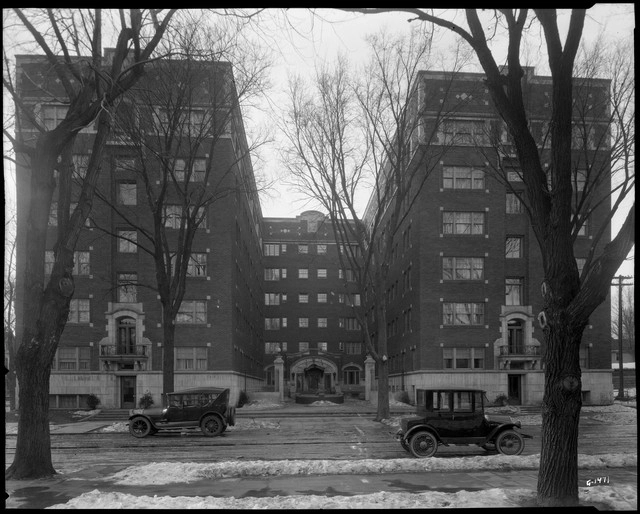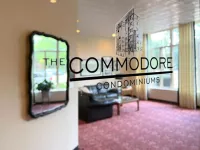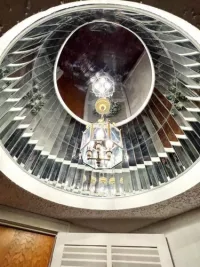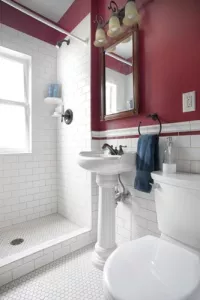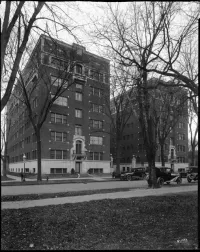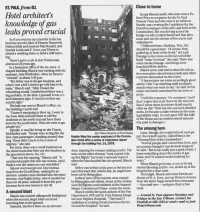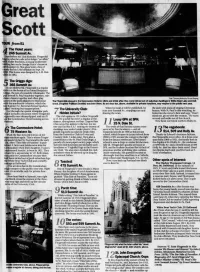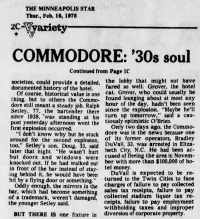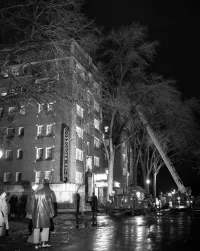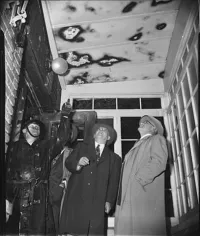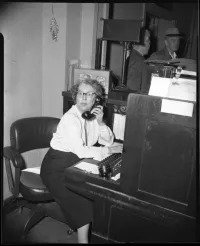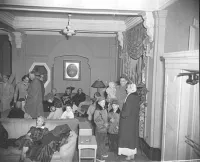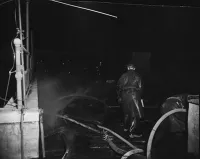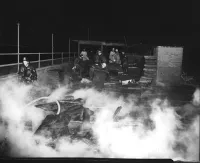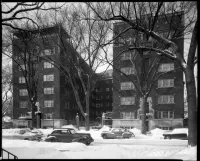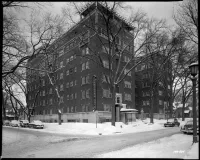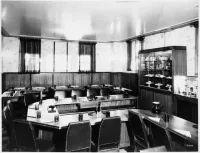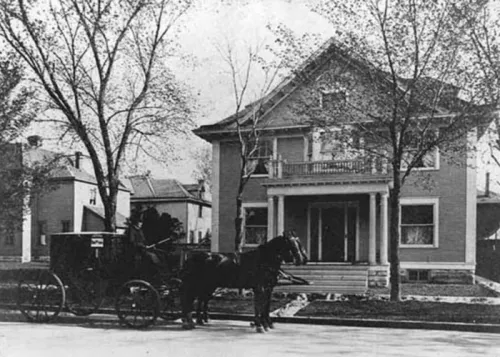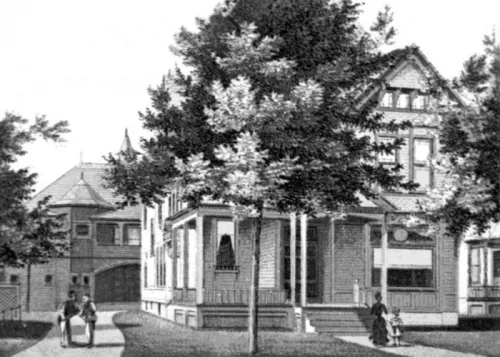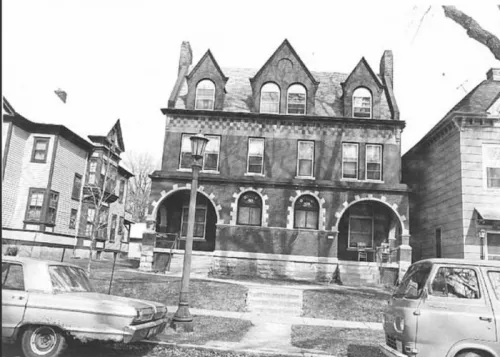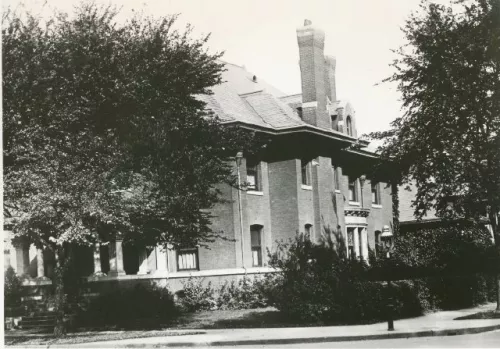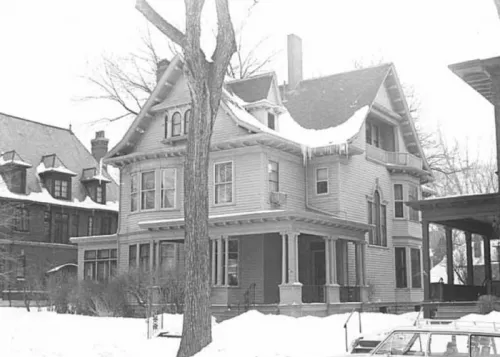Share what you know,
and discover more.
Share what you know,
and discover more.
Feb 10, 2023
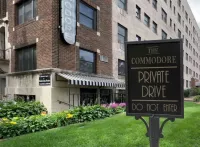
-

- Dave D
The Commodore - Unit 500 For Sale
Listing Agent: Eli Johnson Welcome to this special home in the historic Commodore Building! Benefitting from windows on two sides, this corner unit is light, and bright, and capitalizes on spectacular treetop views of the surrounding Cathedral Hill neighborhood. You'll love the classic vintage personality, coupled with the right updates in the right places. Marble subway tile backsplash, quartz counters, and newer stainless appliances are kitchen highlights. Two updated bathrooms with hex tile floors and subway tile walls. Newer floors & newer paint throughout, a beautiful dental-mantel fireplace surrounded by craftsmen built-ins, white woodwork and doors, and oodles of closet space abound. Fun fact: F. Scott Fitzgerald wandered the halls of this building in its original days as a hotel. Can you just imagine him sipping a martini in the basement speakeasy, which is now the heated underground garage for your car? Don't miss this distinct and rare opportunity for something special! Eli Johnson Real Estate Advisor Engel & Völkers Minneapolis Downtown Cell: 651-357-2536 eli.johnson@evrealestate.com
The Commodore - Unit 500 For Sale
Listing Agent: Eli Johnson Welcome to this special home in the historic Commodore Building! Benefitting from windows on two sides, this corner unit is light, and bright, and capitalizes on spectacular treetop views of the surrounding Cathedral Hill neighborhood. You'll love the classic vintage personality, coupled with the right updates in the right places. Marble subway tile backsplash, quartz counters, and newer stainless appliances are kitchen highlights. Two updated bathrooms with hex tile floors and subway tile walls. Newer floors & newer paint throughout, a beautiful dental-mantel fireplace surrounded by craftsmen built-ins, white woodwork and doors, and oodles of closet space abound. Fun fact: F. Scott Fitzgerald wandered the halls of this building in its original days as a hotel. Can you just imagine him sipping a martini in the basement speakeasy, which is now the heated underground garage for your car? Don't miss this distinct and rare opportunity for something special! Eli Johnson Real Estate Advisor Engel & Völkers Minneapolis Downtown Cell: 651-357-2536 eli.johnson@evrealestate.com
Feb 10, 2023
The Commodore - Unit 500 For Sale
Listing Agent: Eli JohnsonWelcome to this special home in the historic Commodore Building! Benefitting from windows on two sides, this corner unit is light, and bright, and capitalizes on spectacular treetop views of the surrounding Cathedral Hill neighborhood.
You'll love the classic vintage personality, coupled with the right updates in the right places. Marble subway tile backsplash, quartz counters, and newer stainless appliances are kitchen highlights. Two updated bathrooms with hex tile floors and subway tile walls. Newer floors & newer paint throughout, a beautiful dental-mantel fireplace surrounded by craftsmen built-ins, white woodwork and doors, and oodles of closet space abound.
Fun fact: F. Scott Fitzgerald wandered the halls of this building in its original days as a hotel. Can you just imagine him sipping a martini in the basement speakeasy, which is now the heated underground garage for your car? Don't miss this distinct and rare opportunity for something special!
Eli Johnson
Real Estate Advisor
Engel & Völkers Minneapolis Downtown
Cell: 651-357-2536
eli.johnson@evrealestate.com
Posted Date
Feb 10, 2023
Historical Record Date
Feb 10, 2023
Source Name
Engel & Volkers
Delete Story
Are you sure you want to delete this story?
Feb 03, 2023
Feb 03, 2023
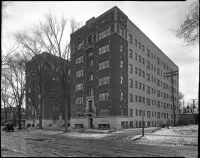
-

- Marley Zielike
About the Commodore
About The Commodore In 1920 the Commodore Hotel opened as the third of Cathedral Hill’s great residential hotels, joining the Blair House (now a condominium like the Commodore) and the Aberdeen (demolished in 1944). 1920 was a time of great change in St. Paul and the nation. The previous ten years saw the construction of the Cathedral, the Saint Paul Hotel, the University Club, the Saint Paul Athletic Club, The Minnesota Club, and the last of the Great Summit Avenue mansions. Change was in the air – the 19th amendment passed, giving women the right to vote. Prohibition began, and with it the age of speakeasies, bathtub gin, and a few gangsters hiding out in St. Paul. During the 1920s Lindbergh makes his solo transatlantic flight, Babe Ruth hit 60 home runs (a record that stood for 30 years), the silent film era ended and the glamorous film age began. The era witnessed the beginnings of the Jazz Age and the Harlem Renaissance. Figures larger than life appeared in politics and the arts, and women became emancipated not just because of the vote – shortening their skirts and dancing the Charleston, they became known as “Flappers”. “Big bands” played and swing dancing became the rage. Grand Art Deco ballrooms and hotels appeared around the world along with the construction of the Waldorf Astoria Hotel in New York – an icon of glamour and luxury opening in the 1931. And of course, the stock market crashed just as the tallest Deco skyscraper in the world, the Empire State Building, began construction. This coincided with construction of another Deco landmark, the First National Bank building. This became St. Paul’s tallest building. And competed with the Empire State Building for building materials during construction. Both buildings, along with the Art Deco City and County Courthouse, were planned and started immediately before the financial panic of the ‘29 stock crash. All three opened during the Depression. Prohibition during the 1920s forced the closure of the Commodore Hotel’s bar. However, the Commodore featured a speakeasy in the basement and hosted the likes of F. Scott Fitzgerald. Many families moved into the Commodore from the Cathedral Hill homes their children had grown up in. Even a few mobsters arrived in town, taking advantage of the O’Conner Rule, which gave the Chicago mob protection from prosecution in St. Paul in return for leaving us alone. By 1933, the Harlem Renaissance was in full swing and the bands of the time played in Harlem at the Apollo, Cotton, & other clubs. The 21st Amendment passed, ending Prohibition. To celebrate, the owners of the Commodore Hotel joined the Art Deco hotel design craze and hired Werner Wittkamp to design a fabulous bar reminiscent of the bars found in some of the then-great transatlantic ocean liners. Mr Wittkamp was born in Berlin and came to the United States to work for Flo Zigfeld’s Zigfeld Follies in New York designing lavish stage sets. He also worked with Max Reinhardt and the great F.W. Murnaw on the sets for many great silent films. As the remodeled bar reopened in 1934, former resident F. Scott Fitzgerald published his novel Tender is the Night to rave reviews. As the Commodore reopens once again after extensive renovation to preserve Wittkamp’s vision, we welcome guests to step back in time and experience the glamour and romance of a bygone era.
About the Commodore
About The Commodore In 1920 the Commodore Hotel opened as the third of Cathedral Hill’s great residential hotels, joining the Blair House (now a condominium like the Commodore) and the Aberdeen (demolished in 1944). 1920 was a time of great change in St. Paul and the nation. The previous ten years saw the construction of the Cathedral, the Saint Paul Hotel, the University Club, the Saint Paul Athletic Club, The Minnesota Club, and the last of the Great Summit Avenue mansions. Change was in the air – the 19th amendment passed, giving women the right to vote. Prohibition began, and with it the age of speakeasies, bathtub gin, and a few gangsters hiding out in St. Paul. During the 1920s Lindbergh makes his solo transatlantic flight, Babe Ruth hit 60 home runs (a record that stood for 30 years), the silent film era ended and the glamorous film age began. The era witnessed the beginnings of the Jazz Age and the Harlem Renaissance. Figures larger than life appeared in politics and the arts, and women became emancipated not just because of the vote – shortening their skirts and dancing the Charleston, they became known as “Flappers”. “Big bands” played and swing dancing became the rage. Grand Art Deco ballrooms and hotels appeared around the world along with the construction of the Waldorf Astoria Hotel in New York – an icon of glamour and luxury opening in the 1931. And of course, the stock market crashed just as the tallest Deco skyscraper in the world, the Empire State Building, began construction. This coincided with construction of another Deco landmark, the First National Bank building. This became St. Paul’s tallest building. And competed with the Empire State Building for building materials during construction. Both buildings, along with the Art Deco City and County Courthouse, were planned and started immediately before the financial panic of the ‘29 stock crash. All three opened during the Depression. Prohibition during the 1920s forced the closure of the Commodore Hotel’s bar. However, the Commodore featured a speakeasy in the basement and hosted the likes of F. Scott Fitzgerald. Many families moved into the Commodore from the Cathedral Hill homes their children had grown up in. Even a few mobsters arrived in town, taking advantage of the O’Conner Rule, which gave the Chicago mob protection from prosecution in St. Paul in return for leaving us alone. By 1933, the Harlem Renaissance was in full swing and the bands of the time played in Harlem at the Apollo, Cotton, & other clubs. The 21st Amendment passed, ending Prohibition. To celebrate, the owners of the Commodore Hotel joined the Art Deco hotel design craze and hired Werner Wittkamp to design a fabulous bar reminiscent of the bars found in some of the then-great transatlantic ocean liners. Mr Wittkamp was born in Berlin and came to the United States to work for Flo Zigfeld’s Zigfeld Follies in New York designing lavish stage sets. He also worked with Max Reinhardt and the great F.W. Murnaw on the sets for many great silent films. As the remodeled bar reopened in 1934, former resident F. Scott Fitzgerald published his novel Tender is the Night to rave reviews. As the Commodore reopens once again after extensive renovation to preserve Wittkamp’s vision, we welcome guests to step back in time and experience the glamour and romance of a bygone era.
About the Commodore
About The CommodoreIn 1920 the Commodore Hotel opened as the third of Cathedral Hill’s great residential hotels, joining the Blair House (now a condominium like the Commodore) and the Aberdeen (demolished in 1944).
1920 was a time of great change in St. Paul and the nation. The previous ten years saw the construction of the Cathedral, the Saint Paul Hotel, the University Club, the Saint Paul Athletic Club, The Minnesota Club, and the last of the Great Summit Avenue mansions. Change was in the air – the 19th amendment passed, giving women the right to vote. Prohibition began, and with it the age of speakeasies, bathtub gin, and a few gangsters hiding out in St. Paul.
During the 1920s Lindbergh makes his solo transatlantic flight, Babe Ruth hit 60 home runs (a record that stood for 30 years), the silent film era ended and the glamorous film age began. The era witnessed the beginnings of the Jazz Age and the Harlem Renaissance. Figures larger than life appeared in politics and the arts, and women became emancipated not just because of the vote – shortening their skirts and dancing the Charleston, they became known as “Flappers”. “Big bands” played and swing dancing became the rage. Grand Art Deco ballrooms and hotels appeared around the world along with the construction of the Waldorf Astoria Hotel in New York – an icon of glamour and luxury opening in the 1931. And of course, the stock market crashed just as the tallest Deco skyscraper in the world, the Empire State Building, began construction. This coincided with construction of another Deco landmark, the First National Bank building. This became St. Paul’s tallest building. And competed with the Empire State Building for building materials during construction. Both buildings, along with the Art Deco City and County Courthouse, were planned and started immediately before the financial panic of the ‘29 stock crash. All three opened during the Depression.
Prohibition during the 1920s forced the closure of the Commodore Hotel’s bar. However, the Commodore featured a speakeasy in the basement and hosted the likes of F. Scott Fitzgerald. Many families moved into the Commodore from the Cathedral Hill homes their children had grown up in. Even a few mobsters arrived in town, taking advantage of the O’Conner Rule, which gave the Chicago mob protection from prosecution in St. Paul in return for leaving us alone.
By 1933, the Harlem Renaissance was in full swing and the bands of the time played in Harlem at the Apollo, Cotton, & other clubs. The 21st Amendment passed, ending Prohibition. To celebrate, the owners of the Commodore Hotel joined the Art Deco hotel design craze and hired Werner Wittkamp to design a fabulous bar reminiscent of the bars found in some of the then-great transatlantic ocean liners. Mr Wittkamp was born in Berlin and came to the United States to work for Flo Zigfeld’s Zigfeld Follies in New York designing lavish stage sets. He also worked with Max Reinhardt and the great F.W. Murnaw on the sets for many great silent films.
As the remodeled bar reopened in 1934, former resident F. Scott Fitzgerald published his novel Tender is the Night to rave reviews.
As the Commodore reopens once again after extensive renovation to preserve Wittkamp’s vision, we welcome guests to step back in time and experience the glamour and romance of a bygone era.
Posted Date
Feb 07, 2023
Historical Record Date
Feb 03, 2023
Source Name
The Commodore Bar
Source Website
Delete Story
Are you sure you want to delete this story?
Jun 01, 2018

-

- Marley Zielike
The Commodore’s History Is Filled with Secret Passages and Notorious Guests
The Commodore’s History Is Filled with Secret Passages and Notorious Guests Photo credit: Emily J. Davis History can often inspire us and in the case of the Commodore Bar and Restaurant, its history was the inspiration behind the reopening. It’s been over a year since the Commodore reopened with a buzz surrounding its bar scene, but when it first opened in 1920, there was no bar. If you know your history, you’ll realize that’s because it opened right after the start of Prohibition —when the production, importation, transportation, and sale of alcohol was outlawed in the United States. This, of course, caused the black market booze scene to pop up and the Commodore to thrive. General manager Lorin Zinter says the Commodore was built as a luxury hotel, and it was common at the time for these hotels to be longer-stay hotels where people would live. “They were essentially like condominiums,” he says. “During the rum-running time, when the Chicago gangsters needed to lay low, they came to Saint Paul. And when they came to Saint Paul, they came to the Commodore.” There was a speakeasy through a secret door and down a few stairs next to what is now the lobby bar, Zinter says; today that space is simply a portion of the parking garage. It’s a part of history that has been lost over time. But during its height, “we had a lot of high-profile gangsters here,” he says. It was in the Commodore that gang leader Ma Barker and her boys planned the Hamm’s heist, where they kidnapped William Hamm of Hamm’s Brewery and held him for ransom. Al Capone was another infamous gangster known to spend time at the hotel, and it is believed John Dillinger was a guest as well. “The Saint Paul-Chicago connection was a very real, and a pretty big, thing at the time,” says Zinter. And then there’s the other famous (or infamous) duo known for their escapades around Saint Paul: Zelda and F. Scott Fitzgerald. The couple lived at the Commodore on two separate occasions in the ’20s, Zinter says. “They were known to enjoy life,” he says. “As [Fitzgerald] liked to say, he drank gin because you couldn’t smell it on his breath. Which is kind of peculiar. I don’t know what gin he was drinking.” But the Fitzgeralds had fun, Zinter says. “Zelda was known to take her clothes off” as she kept drinking, he says. “And so, after enjoying life a little bit too much, they were asked by the ownership to leave the Commodore.” They rented a house in Saint Paul for some time, but ultimately wanted to return to the Commodore. So they returned, asking for a second chance. “The owner said, ‘That’s fine, you’ve learned your lesson.’ But they were promptly kicked out again,” Zinter says. “And then they were asked never to return.” In the present day, the Commodore is returning to some of the ideas born in the rum-runners age. “When we developed the concept, it was based on using local spirits as much as possible and having everything be within a bootlegger’s distance, which is considered a day’s drive,” says Zinter. Minneapolis, Saint Paul and Duluth are prevalent on the spirits list, as are liquors and beers from throughout the Midwest. So when you order your gin drink, you can trust it came from somewhere nearby. And when you take a sip, you can imagine Zelda and Scott drinking something similar and dancing on the bar, almost 100 years ago. Bar manager Jonathan Borchardt says the Commodore Bar and Restaurant draws inspiration from various points throughout cocktail history, including pre-Prohibition cocktails. “You know, things related to a classic old fashioned, the probable prototype of the martini—the Martinez—the Manhattan,” says Borchardt. And then Prohibition hit and tastes changed. “If you’ve heard the term bathtub gin, you know people were doing what they could to get their booze,” he says. These liquors, like moonshine, “are not known to be delicious,” so more sugar and flavorings were added to cocktails. And the Commodore does all of the above (sans moonshine). With all this history, there are things Borchardt has noticed in recent trends. “I have found that people are getting more adventurous,” he says. “Daily, someone will come in and say, ‘I’m kind of feeling like a rye whisky tonight. I’m thinking maybe not citrusy, maybe spirit-forward. Go. Make me something.’ There’s a lot more faith put into the bartender or drinkmaker. We’re being more open-minded.” If you’re looking for a gin drink that will make you feel connected to your favorite 20th-century writer, Borchardt could make you the Fitzgerald, a gin sour that’s both sweet and tart. Or you can make it at home: The Fitzgerald 2 oz. gin 1 oz. fresh lemon juice ½ to 1 oz. simple syrup 2 dashes of Angostura bitters Add the ingredients to a cocktail shaker (filled generously with ice) and shake. Serve on big ice cubes, as they do at the Commodore, or up in a martini glass. Depending on how tart your lemon juice is, adjust the simple syrup to taste.
The Commodore’s History Is Filled with Secret Passages and Notorious Guests
The Commodore’s History Is Filled with Secret Passages and Notorious Guests Photo credit: Emily J. Davis History can often inspire us and in the case of the Commodore Bar and Restaurant, its history was the inspiration behind the reopening. It’s been over a year since the Commodore reopened with a buzz surrounding its bar scene, but when it first opened in 1920, there was no bar. If you know your history, you’ll realize that’s because it opened right after the start of Prohibition —when the production, importation, transportation, and sale of alcohol was outlawed in the United States. This, of course, caused the black market booze scene to pop up and the Commodore to thrive. General manager Lorin Zinter says the Commodore was built as a luxury hotel, and it was common at the time for these hotels to be longer-stay hotels where people would live. “They were essentially like condominiums,” he says. “During the rum-running time, when the Chicago gangsters needed to lay low, they came to Saint Paul. And when they came to Saint Paul, they came to the Commodore.” There was a speakeasy through a secret door and down a few stairs next to what is now the lobby bar, Zinter says; today that space is simply a portion of the parking garage. It’s a part of history that has been lost over time. But during its height, “we had a lot of high-profile gangsters here,” he says. It was in the Commodore that gang leader Ma Barker and her boys planned the Hamm’s heist, where they kidnapped William Hamm of Hamm’s Brewery and held him for ransom. Al Capone was another infamous gangster known to spend time at the hotel, and it is believed John Dillinger was a guest as well. “The Saint Paul-Chicago connection was a very real, and a pretty big, thing at the time,” says Zinter. And then there’s the other famous (or infamous) duo known for their escapades around Saint Paul: Zelda and F. Scott Fitzgerald. The couple lived at the Commodore on two separate occasions in the ’20s, Zinter says. “They were known to enjoy life,” he says. “As [Fitzgerald] liked to say, he drank gin because you couldn’t smell it on his breath. Which is kind of peculiar. I don’t know what gin he was drinking.” But the Fitzgeralds had fun, Zinter says. “Zelda was known to take her clothes off” as she kept drinking, he says. “And so, after enjoying life a little bit too much, they were asked by the ownership to leave the Commodore.” They rented a house in Saint Paul for some time, but ultimately wanted to return to the Commodore. So they returned, asking for a second chance. “The owner said, ‘That’s fine, you’ve learned your lesson.’ But they were promptly kicked out again,” Zinter says. “And then they were asked never to return.” In the present day, the Commodore is returning to some of the ideas born in the rum-runners age. “When we developed the concept, it was based on using local spirits as much as possible and having everything be within a bootlegger’s distance, which is considered a day’s drive,” says Zinter. Minneapolis, Saint Paul and Duluth are prevalent on the spirits list, as are liquors and beers from throughout the Midwest. So when you order your gin drink, you can trust it came from somewhere nearby. And when you take a sip, you can imagine Zelda and Scott drinking something similar and dancing on the bar, almost 100 years ago. Bar manager Jonathan Borchardt says the Commodore Bar and Restaurant draws inspiration from various points throughout cocktail history, including pre-Prohibition cocktails. “You know, things related to a classic old fashioned, the probable prototype of the martini—the Martinez—the Manhattan,” says Borchardt. And then Prohibition hit and tastes changed. “If you’ve heard the term bathtub gin, you know people were doing what they could to get their booze,” he says. These liquors, like moonshine, “are not known to be delicious,” so more sugar and flavorings were added to cocktails. And the Commodore does all of the above (sans moonshine). With all this history, there are things Borchardt has noticed in recent trends. “I have found that people are getting more adventurous,” he says. “Daily, someone will come in and say, ‘I’m kind of feeling like a rye whisky tonight. I’m thinking maybe not citrusy, maybe spirit-forward. Go. Make me something.’ There’s a lot more faith put into the bartender or drinkmaker. We’re being more open-minded.” If you’re looking for a gin drink that will make you feel connected to your favorite 20th-century writer, Borchardt could make you the Fitzgerald, a gin sour that’s both sweet and tart. Or you can make it at home: The Fitzgerald 2 oz. gin 1 oz. fresh lemon juice ½ to 1 oz. simple syrup 2 dashes of Angostura bitters Add the ingredients to a cocktail shaker (filled generously with ice) and shake. Serve on big ice cubes, as they do at the Commodore, or up in a martini glass. Depending on how tart your lemon juice is, adjust the simple syrup to taste.
Jun 01, 2018
The Commodore’s History Is Filled with Secret Passages and Notorious Guests
The Commodore’s History Is Filled with Secret Passages and Notorious GuestsPhoto credit: Emily J. Davis
History can often inspire us and in the case of the Commodore Bar and Restaurant, its history was the inspiration behind the reopening.
It’s been over a year since the Commodore reopened with a buzz surrounding its bar scene, but when it first opened in 1920, there was no bar. If you know your history, you’ll realize that’s because it opened right after the start of Prohibition —when the production, importation, transportation, and sale of alcohol was outlawed in the United States.
This, of course, caused the black market booze scene to pop up and the Commodore to thrive.
General manager Lorin Zinter says the Commodore was built as a luxury hotel, and it was common at the time for these hotels to be longer-stay hotels where people would live. “They were essentially like condominiums,” he says. “During the rum-running time, when the Chicago gangsters needed to lay low, they came to Saint Paul. And when they came to Saint Paul, they came to the Commodore.”
There was a speakeasy through a secret door and down a few stairs next to what is now the lobby bar, Zinter says; today that space is simply a portion of the parking garage. It’s a part of history that has been lost over time. But during its height, “we had a lot of high-profile gangsters here,” he says. It was in the Commodore that gang leader Ma Barker and her boys planned the Hamm’s heist, where they kidnapped William Hamm of Hamm’s Brewery and held him for ransom. Al Capone was another infamous gangster known to spend time at the hotel, and it is believed John Dillinger was a guest as well. “The Saint Paul-Chicago connection was a very real, and a pretty big, thing at the time,” says Zinter.
And then there’s the other famous (or infamous) duo known for their escapades around Saint Paul: Zelda and F. Scott Fitzgerald.
The couple lived at the Commodore on two separate occasions in the ’20s, Zinter says. “They were known to enjoy life,” he says. “As [Fitzgerald] liked to say, he drank gin because you couldn’t smell it on his breath. Which is kind of peculiar. I don’t know what gin he was drinking.”
But the Fitzgeralds had fun, Zinter says. “Zelda was known to take her clothes off” as she kept drinking, he says. “And so, after enjoying life a little bit too much, they were asked by the ownership to leave the Commodore.” They rented a house in Saint Paul for some time, but ultimately wanted to return to the Commodore. So they returned, asking for a second chance. “The owner said, ‘That’s fine, you’ve learned your lesson.’ But they were promptly kicked out again,” Zinter says. “And then they were asked never to return.”
In the present day, the Commodore is returning to some of the ideas born in the rum-runners age. “When we developed the concept, it was based on using local spirits as much as possible and having everything be within a bootlegger’s distance, which is considered a day’s drive,” says Zinter. Minneapolis, Saint Paul and Duluth are prevalent on the spirits list, as are liquors and beers from throughout the Midwest.
So when you order your gin drink, you can trust it came from somewhere nearby. And when you take a sip, you can imagine Zelda and Scott drinking something similar and dancing on the bar, almost 100 years ago.
Bar manager Jonathan Borchardt says the Commodore Bar and Restaurant draws inspiration from various points throughout cocktail history, including pre-Prohibition cocktails. “You know, things related to a classic old fashioned, the probable prototype of the martini—the Martinez—the Manhattan,” says Borchardt. And then Prohibition hit and tastes changed. “If you’ve heard the term bathtub gin, you know people were doing what they could to get their booze,” he says. These liquors, like moonshine, “are not known to be delicious,” so more sugar and flavorings were added to cocktails. And the Commodore does all of the above (sans moonshine).
With all this history, there are things Borchardt has noticed in recent trends. “I have found that people are getting more adventurous,” he says. “Daily, someone will come in and say, ‘I’m kind of feeling like a rye whisky tonight. I’m thinking maybe not citrusy, maybe spirit-forward. Go. Make me something.’ There’s a lot more faith put into the bartender or drinkmaker. We’re being more open-minded.”
If you’re looking for a gin drink that will make you feel connected to your favorite 20th-century writer, Borchardt could make you the Fitzgerald, a gin sour that’s both sweet and tart. Or you can make it at home:
The Fitzgerald
2 oz. gin
1 oz. fresh lemon juice
½ to 1 oz. simple syrup
2 dashes of Angostura bitters
Add the ingredients to a cocktail shaker (filled generously with ice) and shake. Serve on big ice cubes, as they do at the Commodore, or up in a martini glass. Depending on how tart your lemon juice is, adjust the simple syrup to taste.
Posted Date
Feb 10, 2023
Historical Record Date
Jun 01, 2018
Source Name
Lake Minnetonka Magazine
Delete Story
Are you sure you want to delete this story?
Feb 23, 1998
Feb 23, 1998
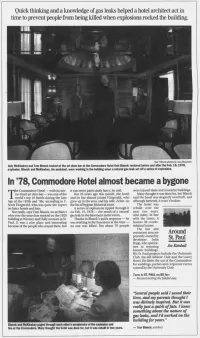
In '78, Commodore Hotel almost became a bygone
In '78, Commodore Hotel almost became a bygone. By Joe Kimball Quick thinking and knowledge of gas leaks helped a hotel architect act in time to prevent people from being killed when an explosion rocked the building.
In '78, Commodore Hotel almost became a bygone
In '78, Commodore Hotel almost became a bygone. By Joe KimballQuick thinking and knowledge of gas leaks helped a hotel architect act in time to prevent people from being killed when an explosion rocked the building.
Posted Date
Feb 10, 2023
Historical Record Date
Feb 23, 1998
Source Name
Star Tribune
Delete Story
Are you sure you want to delete this story?
Sep 15, 1996
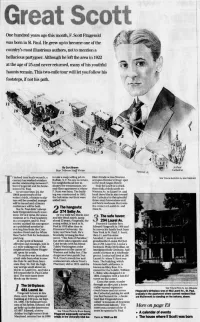
-

- Marley Zielike
Great Scott
Great Scott One hundred years ago this month, F. Scott Fitzgerald was born in St. Paul. He grew up to become one of the country's most illustrious authors, not to mention a hellacious partygoer. Although he left the area in 1922 at the age of 25 and never returned. This two-mile tour will let you follow his footsteps, if not his path.
Great Scott
Great Scott One hundred years ago this month, F. Scott Fitzgerald was born in St. Paul. He grew up to become one of the country's most illustrious authors, not to mention a hellacious partygoer. Although he left the area in 1922 at the age of 25 and never returned. This two-mile tour will let you follow his footsteps, if not his path.
Sep 15, 1996
Great Scott
Great ScottOne hundred years ago this month, F. Scott Fitzgerald was born in St. Paul. He grew up to become one of the country's most illustrious authors, not to mention a hellacious partygoer. Although he left the area in 1922 at the age of 25 and never returned. This two-mile tour will let you follow his footsteps, if not his path.
Posted Date
Feb 09, 2023
Historical Record Date
Sep 15, 1996
Source Name
Star Tribune
Delete Story
Are you sure you want to delete this story?
Dec 09, 1979
Dec 09, 1979
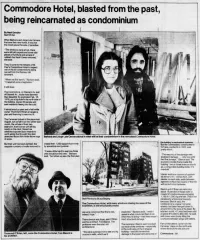
Commodore Hotel, blasted from the past, being reincarnated as condominium
Commodore Hotel, blasted from the past, being reincarnated as condominium. By Neal Gendier
Delete Story
Are you sure you want to delete this story?
Feb 16, 1978
Feb 16, 1978
Delete Story
Are you sure you want to delete this story?
Feb 16, 1978
Feb 16, 1978
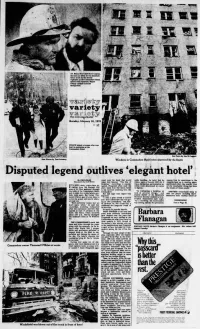
The Commodore Hotel Explosion
The Commodore Hotel Explosion. "Disputed legend outlives 'elegant hotel'" By Joe Logan for The Minneapolis Star
Delete Story
Are you sure you want to delete this story?
Nov 06, 1952
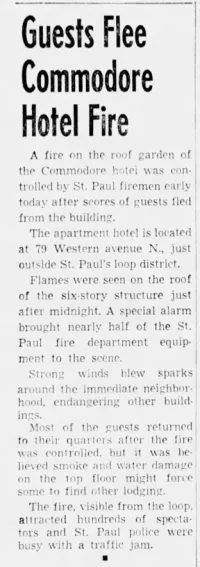
-

- Marley Zielike
The Commodore Hotel Roof Fire
Guest Flee Commodore Hotel Fire A fire on the roof garden of the Commodore hotel was controlled by St. Paul firemen early today after scores of guests fled from the building. The apartment hotel is located at 79 Western Avenue N., just outside of St. Paul's loop district. Flames were seen on the roof of the six-story structure just after midnight. A special alarm brought nearly half of the St. Paul fire department equipment to the scene. Strong winds blew sparks around the immediate neighborhood, endangering other buildings. Most of the guests returned to their quarters after the fire was controlled, but it was believed smoke and water damage on the top floor might force some to find other lodgings. The fire, visible from the loop, attracted hundreds of spectators and St. Paul police were busy with a traffic jam.
The Commodore Hotel Roof Fire
Guest Flee Commodore Hotel Fire A fire on the roof garden of the Commodore hotel was controlled by St. Paul firemen early today after scores of guests fled from the building. The apartment hotel is located at 79 Western Avenue N., just outside of St. Paul's loop district. Flames were seen on the roof of the six-story structure just after midnight. A special alarm brought nearly half of the St. Paul fire department equipment to the scene. Strong winds blew sparks around the immediate neighborhood, endangering other buildings. Most of the guests returned to their quarters after the fire was controlled, but it was believed smoke and water damage on the top floor might force some to find other lodgings. The fire, visible from the loop, attracted hundreds of spectators and St. Paul police were busy with a traffic jam.
Nov 06, 1952
The Commodore Hotel Roof Fire
Guest Flee Commodore Hotel FireA fire on the roof garden of the Commodore hotel was controlled by St. Paul firemen early today after scores of guests fled from the building.
The apartment hotel is located at 79 Western Avenue N., just outside of St. Paul's loop district.
Flames were seen on the roof of the six-story structure just after midnight. A special alarm brought nearly half of the St. Paul fire department equipment to the scene.
Strong winds blew sparks around the immediate neighborhood, endangering other buildings.
Most of the guests returned to their quarters after the fire was controlled, but it was believed smoke and water damage on the top floor might force some to find other lodgings.
The fire, visible from the loop, attracted hundreds of spectators and St. Paul police were busy with a traffic jam.
Posted Date
Feb 10, 2023
Historical Record Date
Nov 06, 1952
Source Name
The Star Tribune
Delete Story
Are you sure you want to delete this story?
Jan 23, 1951
Jan 23, 1951
Delete Story
Are you sure you want to delete this story?
Sep 12, 1945
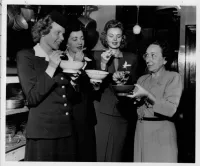
Minnesota Stewardesses Train to Use Chopsticks
Rosie Stein, from the Commodore Hotel, demonstrates to 2 new recruits and chief stewardesses before they fly to Pacific areas on Northwest Airlines. L to R: English, Rowland, Rudquist, Stein.
Sep 12, 1945
Minnesota Stewardesses Train to Use Chopsticks
Rosie Stein, from the Commodore Hotel, demonstrates to 2 new recruits and chief stewardesses before they fly to Pacific areas on Northwest Airlines. L to R: English, Rowland, Rudquist, Stein.Posted Date
Feb 10, 2023
Historical Record Date
Sep 12, 1945
Source Name
Hennepin County Library and the Hennepin History Museum
Delete Story
Are you sure you want to delete this story?
Jun 01, 1945
Jun 01, 1945
Coffee shop, Commodore Hotel, St. Paul
Coffee shop at the Commodore Hotel in St. Paul. Approximately 1945Posted Date
Feb 09, 2023
Historical Record Date
Jun 01, 1945
Source Name
Minnesota Historical Society
Delete Story
Are you sure you want to delete this story?
Mar 02, 1943
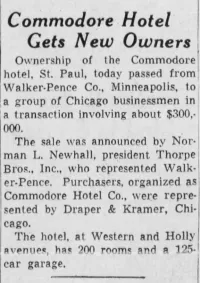
Commodore Hotel Gets New Owners
Commodore Hotel Gets New Owners Ownership of the Commodore hotel, St. Paul, today passed from Walker-Pence Co, Minneapolis, to a group of Chicago businessmen in a transaction involving about $300,000.
Mar 02, 1943
Commodore Hotel Gets New Owners
Commodore Hotel Gets New OwnersOwnership of the Commodore hotel, St. Paul, today passed from Walker-Pence Co, Minneapolis, to a group of Chicago businessmen in a transaction involving about $300,000.
Posted Date
Feb 10, 2023
Historical Record Date
Mar 02, 1943
Source Name
The Minneapolis Star
Delete Story
Are you sure you want to delete this story?
Feb 07, 1941
Feb 07, 1941
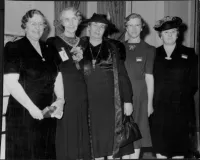
-

- Dave D
Minnesota Federation of Women's Clubs
Taking part in the 37th annual mid-winter council meeting held at the Hotel Commodore are (L to R): Upham is state president, McConnell is 4th district federation president, Mrs. Louis, Mrs. Anderson of Willmar is first vice president and Mrs. Satterlee is state treasurer.
Minnesota Federation of Women's Clubs
Taking part in the 37th annual mid-winter council meeting held at the Hotel Commodore are (L to R): Upham is state president, McConnell is 4th district federation president, Mrs. Louis, Mrs. Anderson of Willmar is first vice president and Mrs. Satterlee is state treasurer.
Minnesota Federation of Women's Clubs
Taking part in the 37th annual mid-winter council meeting held at the Hotel Commodore are (L to R): Upham is state president, McConnell is 4th district federation president, Mrs. Louis, Mrs. Anderson of Willmar is first vice president and Mrs. Satterlee is state treasurer.Posted Date
Feb 10, 2023
Historical Record Date
Feb 07, 1941
Source Name
Hennepin County Library and the Hennepin History Museum
Delete Story
Are you sure you want to delete this story?
Dec 11, 1938
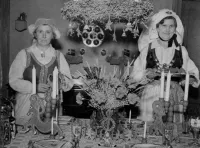
Swedish Christmas theme for a meeting of the Minnesota Garden Flower Society
Magney, left, and Gorgenson stand behind their decorated table designed in the Swedish Christmas theme for a meeting of the Minnesota Garden Flower Society to be held at the Commodore hotel in St. Paul.
Dec 11, 1938
Swedish Christmas theme for a meeting of the Minnesota Garden Flower Society
Magney, left, and Gorgenson stand behind their decorated table designed in the Swedish Christmas theme for a meeting of the Minnesota Garden Flower Society to be held at the Commodore hotel in St. Paul.Posted Date
Feb 10, 2023
Historical Record Date
Dec 11, 1938
Source Name
Hennepin County Library and the Hennepin History Museum
Delete Story
Are you sure you want to delete this story?
Jun 17, 1938
Jun 17, 1938
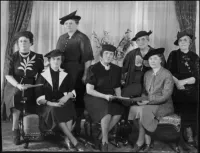
-

- Dave D
Degree of Honor Protective Association
Plans for the triennial national convention of the association are being made by this group of women at their luncheon meeting at the Hotel Commodore. Shown (L to R): Bender of St. Paul is national vice president and grand secretary, Olson of St. Paul is national president, McCann is grand vice president, Dugan of St. Paul is national juvenile director, Effertz of St. Paul is past grand president, Christianson of St. Paul is grand president, Heintz is past grand president.
Degree of Honor Protective Association
Plans for the triennial national convention of the association are being made by this group of women at their luncheon meeting at the Hotel Commodore. Shown (L to R): Bender of St. Paul is national vice president and grand secretary, Olson of St. Paul is national president, McCann is grand vice president, Dugan of St. Paul is national juvenile director, Effertz of St. Paul is past grand president, Christianson of St. Paul is grand president, Heintz is past grand president.
Degree of Honor Protective Association
Plans for the triennial national convention of the association are being made by this group of women at their luncheon meeting at the Hotel Commodore. Shown (L to R): Bender of St. Paul is national vice president and grand secretary, Olson of St. Paul is national president, McCann is grand vice president, Dugan of St. Paul is national juvenile director, Effertz of St. Paul is past grand president, Christianson of St. Paul is grand president, Heintz is past grand president.Posted Date
Feb 10, 2023
Historical Record Date
Jun 17, 1938
Source Name
Hennepin County Library and the Hennepin History Museum
Delete Story
Are you sure you want to delete this story?
Mar 01, 1925
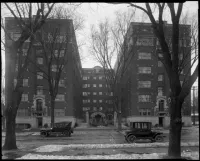
The Commodore Hotel
Commodore Hotel, 79 Western Avenue North, St. Paul. Photographer: Gibson, Charles P. Content: Approximately 1925
Mar 01, 1925
The Commodore Hotel
Commodore Hotel, 79 Western Avenue North, St. Paul.Photographer: Gibson, Charles P.
Content: Approximately 1925
Posted Date
Feb 07, 2023
Historical Record Date
Mar 01, 1925
Source Name
Minnesota Historical Society
Delete Story
Are you sure you want to delete this story?
